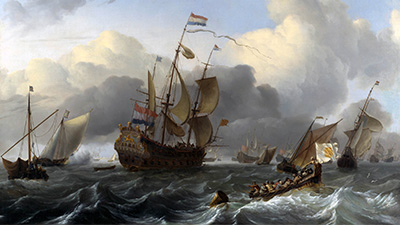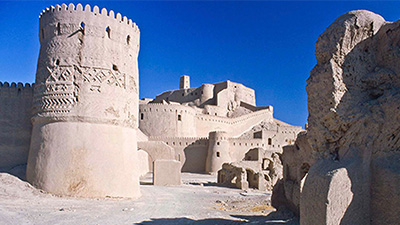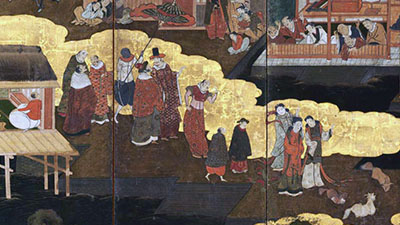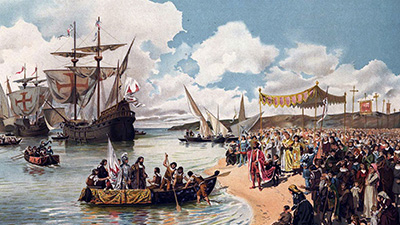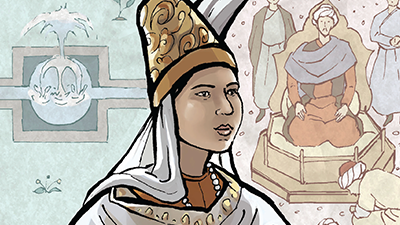Age of Exploration
Teacher Resources
Driving Question: Why did European monarchs fund voyages of exploration and conquest in this period?
European maritime voyages launched in the fifteenth and sixteenth centuries transformed the world. They linked the hemispheres in sustained connection for the first time. As a result of these voyages, European states began building vast and powerful overseas empires that stretched across oceans.
Learning Objectives:
- Describe how the exchange of innovations and technology allowed European states to expand and establish new oceanic empires.
- Compare new types of empires that were established in this era, built on gunpowder and navigational innovations.
- Use a graphic biography to support, extend, or challenge the overarching narratives from this period.
Vocab Terms:
- commodity
- conquistador
- finance
- indigenous
- mercantilism
- plantation
- rationalization
Opener: Age of Exploration
To teach this lesson step, refer to page 3 of the Lesson 6.7 Teaching Guide.
Looking for additional ways to introduce this topic? Check out another teacher’s approach in Age of Exploration Introduction Activity Using Apple Pie thread in the Community Forum.
What are the terms you’ll need to know for this lesson? Check out some new vocabulary and look back on what you’ve already learned.
Crossing the Atlantic
To teach this lesson step, refer to page 3 of the Lesson 6.7 Teaching Guide.
The Three-Step Reading Worksheet is available to support students while they read this article.
In the fifteenth century, explorers from Europe set out across the oceans. Their voyages and conquests made some Europeans very rich and some rulers very powerful. But as you’ll see in the article below, not everyone shared equally.
-
Guiding Questions
-
Before you read
Preview the questions below, and then skim the article. Be sure to look at the section headings and any images.
While you read
Look for answers to these questions:
- What was the biggest motivation behind the European voyages of exploration?
- Why were the small islands off the coast of West Africa important to European expansion?
- These voyages were dangerous. Why did explorers, merchants, and rulers accept the risks?
- What advantages did joint stock companies provide?
After you read
Respond to this question: Can you think of one economic cause that led to European voyages across the Atlantic Ocean?
New Empires
To teach this lesson step, refer to page 4 of the Lesson 6.7 Teaching Guide.
OER Project teachers have some great ideas for Engaging Classroom Activities on Land-Based Empires and Gunpowder.
Were European oceanic empires something new, or were they just another form of empire? Use these articles and activity to compare old land-based empires with the emergence of new oceanic empires.
-
Guiding Questions
-
Before you read
Preview the questions below, and then skim the article. Be sure to look at the section headings and any images.
While you read
Look for answers to these questions:
- Which empires are referred to as gunpowder empires and why are they called this?
- How did gunpowder help emperors rule their territories?
- How were the Mongols important to these new empires?
- How did these empires use religion to govern?
- How did gunpowder technology change political dynamics in Europe?
After you read
Respond to these questions: Do you think gunpowder empires is a good name for these empires? Why or why not? Can you think of a better name?
-
Guiding Questions
-
Before you read
Preview the questions below, and then skim the article. Be sure to look at the section headings and any images.
While you read
Look for answers to these questions:
- What were the main empires that took part in the maritime expansion in this period?
- What were the main regions that these empires expanded into during this period?
- Who were the “private actors” in this phase of imperial expansion? Can you note any examples?
- What were some of the main reasons for the imperial maritime expansions in this period?
- What product was in demand in Europe and drove plantation economies across the Atlantic Ocean?
After you read
Respond to this question: How did the new global networks described in this article change societies around the world?
Routes to the East
To teach this lesson step, refer to page 6 of the Lesson 6.7 Teaching Guide.
European navigators also traveled to the Indian Ocean in search of new trade opportunities. In this article and graphic bio, you’ll read about their interactions with powerful states and a flourishing network of trade.
-
Guiding Questions
-
Before you read
Preview the questions below, and then skim the article. Be sure to look at the section headings and any images.
While you read
Look for answers to these questions:
- What was the immediate impact of Europeans arriving in the Indian Ocean?
- How did the rulers of Indian Ocean states view the arrival of the Portuguese?
- Why were diaspora communities important to the Indian Ocean world?
- What role did the Armenian diaspora have in extending the influence of European empires in the Indian Ocean?
After you read
Respond to this question: What role did states play in the expansion of maritime exploration during this period?
-
Guiding Questions
-
Before you read
Preview the questions below, and then skim the comic, paying attention to things like prominent colors, shapes, and types of text and fonts. How do you know where to start and in which direction to read? What’s in the gutters (the space between panels)? Who or what is the focus of the comic?
While you read
- Where was Yasuke likely from and how did he get to Japan?
- What was Yasuke’s relationship with Oda Nobunaga?
- What happened to Yasuke after Oda Nobunaga was killed?
- What else do we know about Yasuke?
- How does the artist’s depiction of Yasuke change across the page?
After you read
Respond to this question: How does this biography of Yasuke support, extend, or challenge what you have learned about oceanic connections and networks in this period?
Closer: Age of Exploration
To teach this lesson step, refer to page 8 of the Lesson 6.7 Teaching Guide.
Reflection is vital to self-assessment. Read more in the OER Project Assessment Guide.
In this lesson, you’ve explored voyages of exploration and conquest. Reflect on what you learned, what surprised you, and any questions you still have.
The Global Silver Trade
To teach this lesson step, refer to page 8 of the Lesson 6.7 Teaching Guide.
The Spanish Empire extracted huge amounts of silver from their colonies in the Americas. The sudden abundance of this precious metal totally reshaped global economic patterns.
-
Guiding Questions
-
Before you watch
Preview the questions below, and then review the transcript.
While you watch
Look for answers to these questions:
- What are some aspects of Inca society that strengthened their empire?
- What resource did the Spanish find instead of gold, and how did they extract this resource?
- What were the economic results of Spanish silver mining in the Americas?
- What other country had a problem with inflation? How did they try to deal with it, and were they successful?
- What were some effects of China’s new tax structure in the sixteenth century?
After you watch
Respond to this question: What were the overall global effects of Spanish silver mining?
Key Ideas
Capitalism and Empire
To teach this lesson step, refer to page 9 of the Lesson 6.7 Teaching Guide.
The emerging system of capitalism supported the expansion of European empires—just as those empires helped expand the system of capitalism. Explore the global connections that made it all possible.
-
Guiding Questions
-
Before you read
Preview the questions below, and then skim the article. Be sure to look at the section headings and any images.
While you read
Look for answers to these questions:
- In what ways was the European use of credit in this period a continuation of older practices? In what ways was it a change?
- What was the impact of Fibonacci’s book?
- Why was a bill of exchange useful?
- What financial innovation did the British East India Company and Dutch East India Company rely on?
- What was the economic role of colonies for Europeans in this era?
After you read
Respond to these questions: We tend to think that exchange and trade between societies is always a good thing. Does this article change your opinion? How?
The Mughals
To teach this lesson step, refer to page 10 of the Lesson 6.7 Teaching Guide.
The Mughal Empire produced many goods for trade, but spent a lot of their time trying to keep their people working together. This graphic biography will help you understand how they did it.
-
Guiding Questions
-
Before you read
Preview the questions below, and then skim the comic, paying attention to things like prominent colors, shapes, and types of text and fonts. How do you know where to start and in which direction to read? What’s in the gutters (the space between panels)? Who or what is the focus of the comic?
While you read
- How was Khanzada Begum related to the first Mughal emperors, Babur and Humayun?
- Why did Khanzada Begum marry Muhammad Shaybani Khan, and why were they divorced?
- How did Khanzada Begum help her brother in his conflict with the Uzbeks after her divorce?
- How did Khanzada Begum help her nephew rule?
- How does the artist use art and design to demonstrate the power and authority of Khanzada Begum?
After you read
Respond to this question: How does this biography of Khanzada Begum support, extend, or challenge what you have learned about the gunpowder empires in this period?
An African Oceanic Empire?
To teach this lesson step, refer to page 11 of the Lesson 6.7 Teaching Guide.
Explore a nontypical maritime-based empire and rethink the characteristics of empires during this period.
-
Guiding Questions
-
Before you watch
Preview the questions below, and then review the transcript.
While you watch
Look for answers to these questions:
- What makes the Omani Empire different from other Islamic empires?
- What areas did the Omani Empire cover at its peak?
- How did the Omani Empire come to be an empire?
- What are two key differences between the Omani Empire and most other empires?
- How did the Omani Empire change East Africa in the long term?
After you watch
Respond to these questions: Do you think the Omani Empire was actually an empire? Why or why not?


